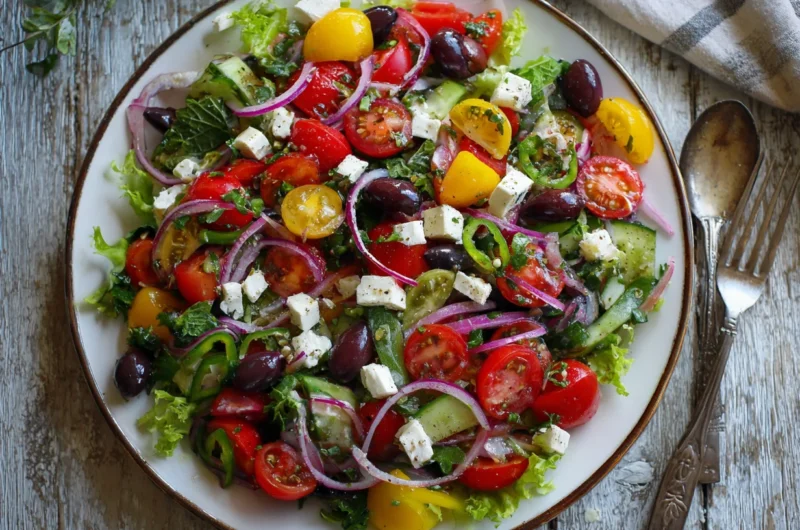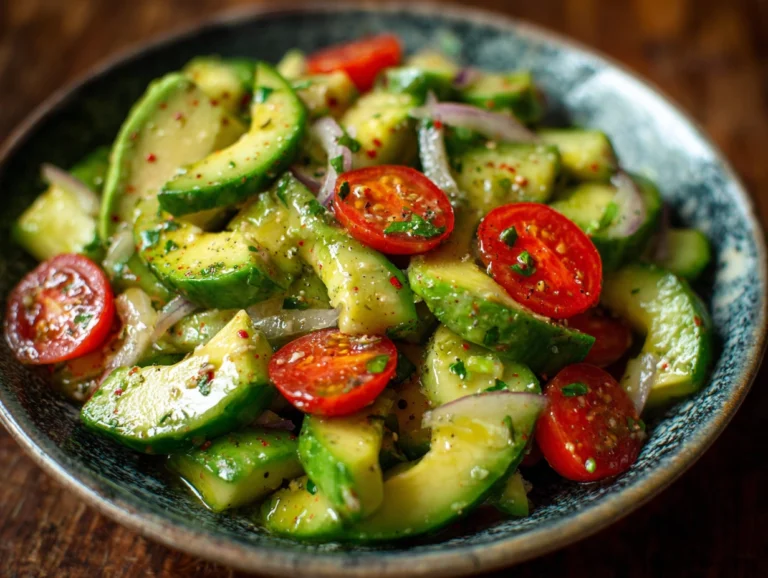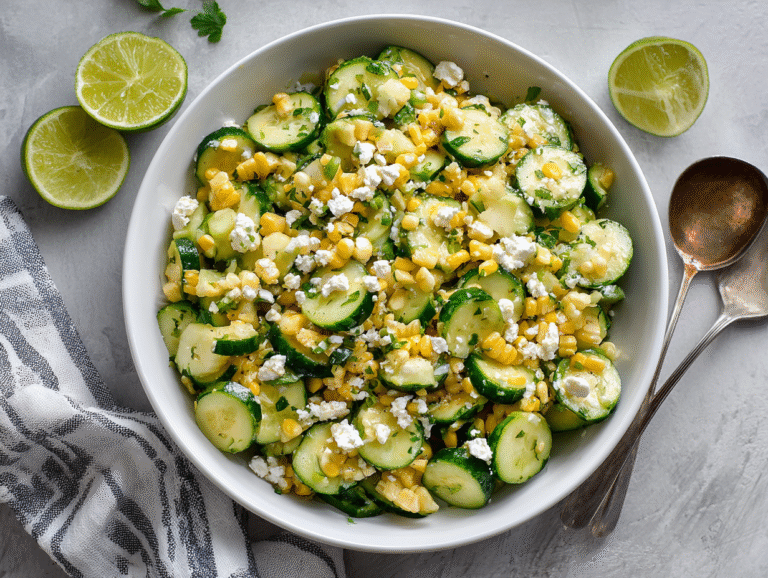Best Greek Salad Recipe
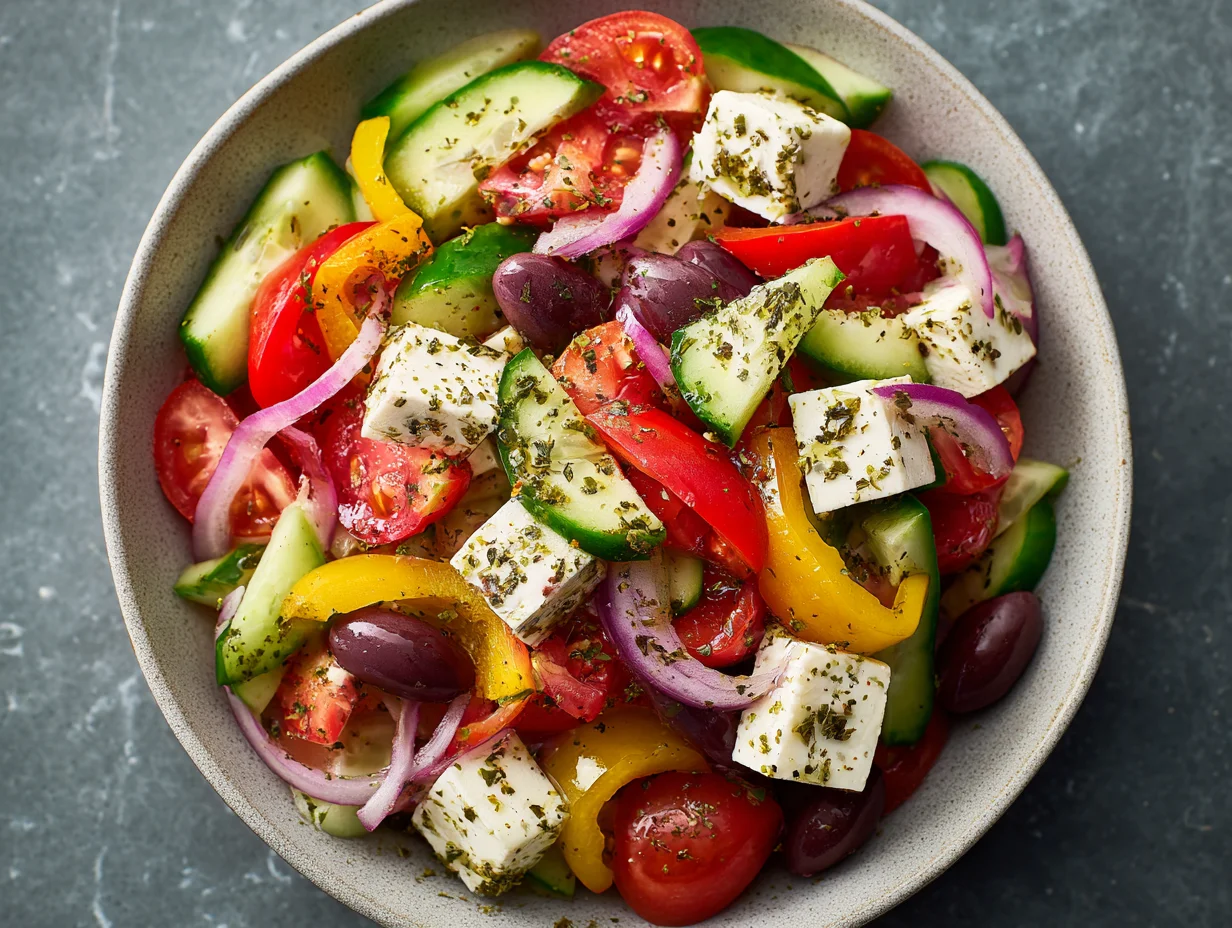
Crisp, vibrant, and unapologetically bold, the Greek Salad is a masterclass in simplicity done right. With every bite, you taste the sun-soaked shores of the Aegean—ripe tomatoes, briny olives, and creamy feta, all elevated by a drizzle of golden olive oil. This isn’t a “lite side dish.” It’s a refreshing, full-flavored centerpiece that deserves a seat at every table, from casual summer lunches to elegant Mediterranean spreads. As a professional chef, I’ll walk you through how to create the best Greek salad—balanced, authentic, and unforgettable.
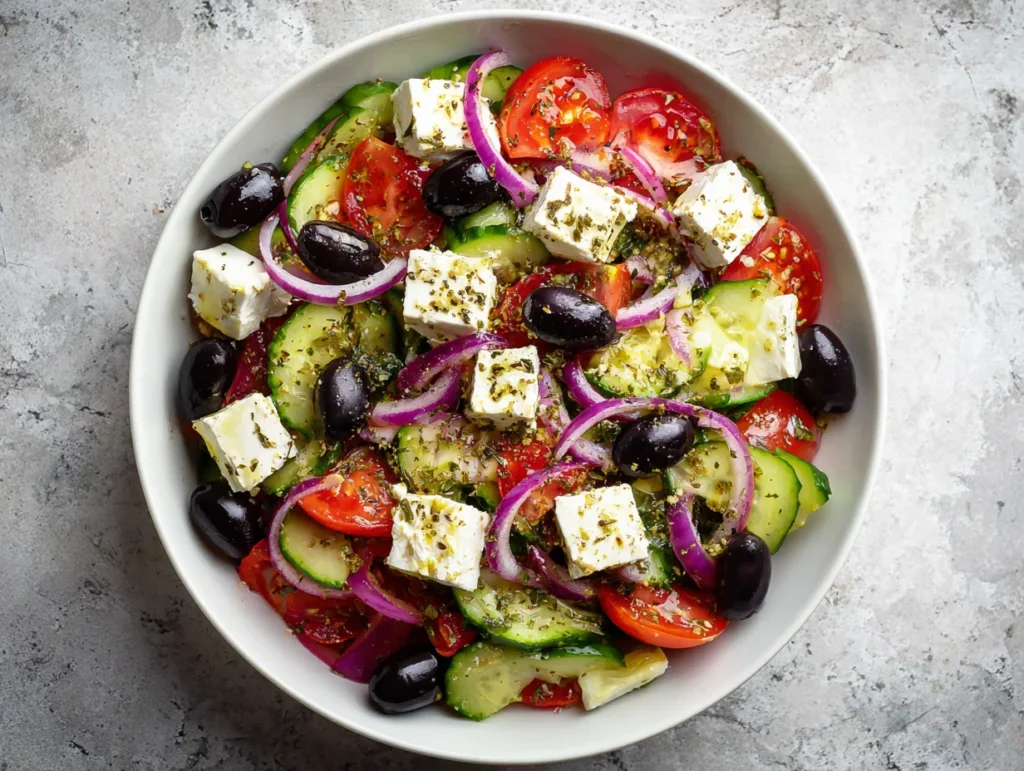
Ingredients List
For the Salad:
- 4 ripe tomatoes, cut into large wedges
- 1 English cucumber, peeled in stripes and sliced into half-moons
- 1 small red onion, thinly sliced
- 1 green bell pepper, sliced into rings
- ¾ cup Kalamata olives (whole, unpitted preferred for flavor)
- 200g (7 oz) block of Greek feta cheese, cut into thick slabs
- 1 tsp dried Greek oregano
For the Dressing:
- ¼ cup high-quality extra virgin olive oil
- 1 tbsp red wine vinegar
- Freshly ground black pepper, to taste
- Sea salt, to taste (use sparingly; feta and olives add salt)
Step-by-Step Instructions
Step 1: Use Ripe, In-Season Produce
Start with the freshest vegetables you can find. Greek salad relies heavily on ingredient quality—look for tomatoes that are heavy, fragrant, and slightly soft.
Step 2: Layer with Purpose
In a wide, shallow serving bowl, layer the tomatoes, cucumber, bell pepper, and red onion. Avoid mixing too aggressively this isn’t a tossed salad. The layering keeps textures crisp and presentation stunning.
Step 3: Add the Salty Contrast
Scatter whole Kalamata olives across the salad. Place the feta slabs gently on top—never crumbled. The authentic presentation keeps it rustic and allows guests to break off bites as desired.
Step 4: Dress Like a Local
Whisk together olive oil, vinegar, a pinch of sea salt, and cracked pepper. Drizzle generously over the salad. Finish with a dusting of dried oregano over the feta.
Step 5: Let It Rest (Optional)
Let the salad sit for 10–15 minutes before serving. The flavors will meld slightly, and the vegetables will absorb the dressing without wilting.
Cook Time
- Prep Time: 15 minutes
- Total Time: 15 minutes
- No cooking required
Servings
- Serves 4 as a side dish, or 2 as a light main
Nutritional Information (approx. per serving)
- Calories: 240
- Protein: 6g
- Fat: 20g (mostly from olive oil and feta)
- Carbohydrates: 9g
- Fiber: 3g
- Sugar: 5g
- Sodium: 600mg
Storage Instructions
This salad is best eaten fresh. However, if needed:
- Refrigerate leftovers in an airtight container for up to 1 day.
- Keep feta and dressing separate if preparing in advance.
- Avoid freezing it destroys the texture of the vegetables.
Suggestions
- Protein Additions: Pair with grilled lamb chops, chicken souvlaki, or pan-seared halloumi for a heartier meal.
- Bread: Serve with warm pita, rustic sourdough, or crusty village bread to mop up the dressing.
- Wine Pairing: A crisp Assyrtiko from Santorini or a dry rosé complements the salty-bright profile beautifully.
Seasonal Relevance
Best in Summer and Early Fall, when tomatoes and cucumbers are at their flavorful peak. That said, a well-sourced winter tomato and a good block of barrel-aged feta can still make this salad shine even in cooler months.
Conclusion
A true Greek salad isn’t about fancy techniques—it’s about honoring each ingredient. With the right balance of freshness, salinity, and acidity, this dish becomes more than a salad. It’s a lesson in restraint, culture, and the power of good olive oil. Whether served as a quick weekday lunch or a weekend mezze centerpiece, this is the best Greek salad you’ll ever make—and one that just might become a staple in your kitchen.
Greek Salad Recipe
4
servings15
minutes240
kcalA vibrant and authentic Greek salad that showcases the bold flavors of the Mediterranean. Made with ripe tomatoes, crisp cucumbers, creamy feta, and briny Kalamata olives, this no-cook salad is fresh, healthy, and perfect as a light meal or side. Finished with a drizzle of olive oil and a sprinkle of oregano, it’s simplicity at its best—ideal for summer meals or year-round eating.
Ingredients
4 ripe tomatoes, cut into large wedges
1 English cucumber, peeled in stripes and sliced
1 small red onion, thinly sliced
1 green bell pepper, sliced into rings
¾ cup whole Kalamata olives
200g (7 oz) Greek feta cheese block, sliced
1 tsp dried Greek oregano
Dressing:
¼ cup extra virgin olive oil
1 tbsp red wine vinegar
Sea salt, to taste
Freshly ground black pepper, to taste
Directions
- Layer tomatoes, cucumber, bell pepper, and red onion in a wide serving dish without tossing.
- Add olives and top with thick slices of feta.
- Whisk olive oil, vinegar, salt, and pepper in a small bowl. Drizzle over the salad.
- Sprinkle dried oregano on top of the feta.
- Let rest for 10–15 minutes before serving for best flavor.
Recipe Video
Notes
- Use a high-quality block of feta—barrel-aged Greek feta is ideal.
- Don’t substitute crumbled feta; the presentation and texture matter.
- Serve immediately, or rest briefly to let flavors meld.
- Pairs well with grilled meats, seafood, or crusty bread.
- Avoid adding lettuce this is a traditional horiatiki, not an Americanized version.
FAQs
Q1: Can I use crumbled feta instead of a block?
You can, but it’s not traditional. A block holds moisture better and adds to the rustic presentation.
Q2: What’s the best olive oil for Greek salad?
Use a cold-pressed, extra virgin olive oil—preferably Greek. Look for one with a peppery finish and fruity aroma.
Q3: Can I add lettuce or avocado to Greek salad?
Technically, no. Lettuce and avocado are not part of the authentic horiatiki (village) salad. If you do add them, it becomes a fusion dish.

